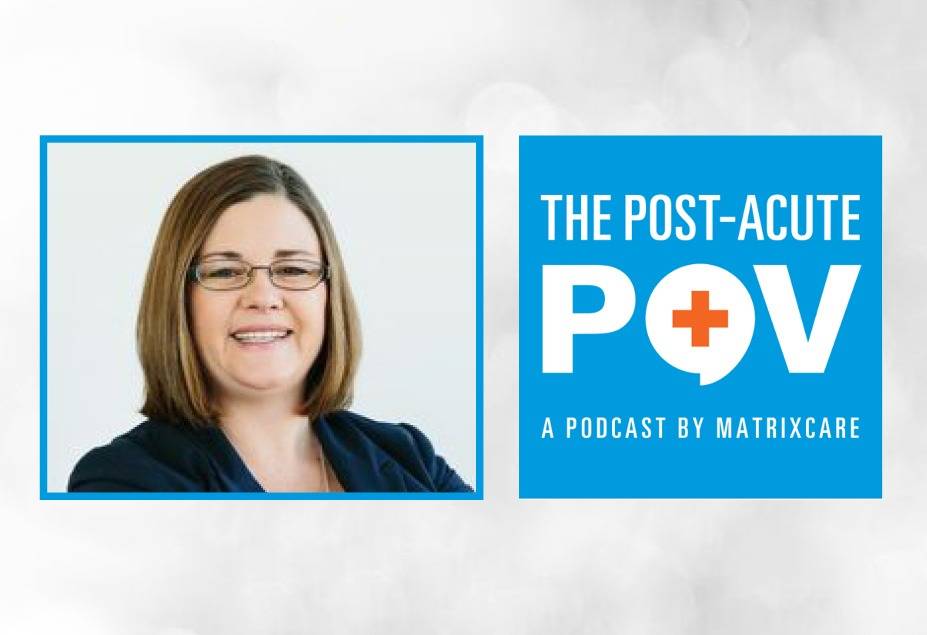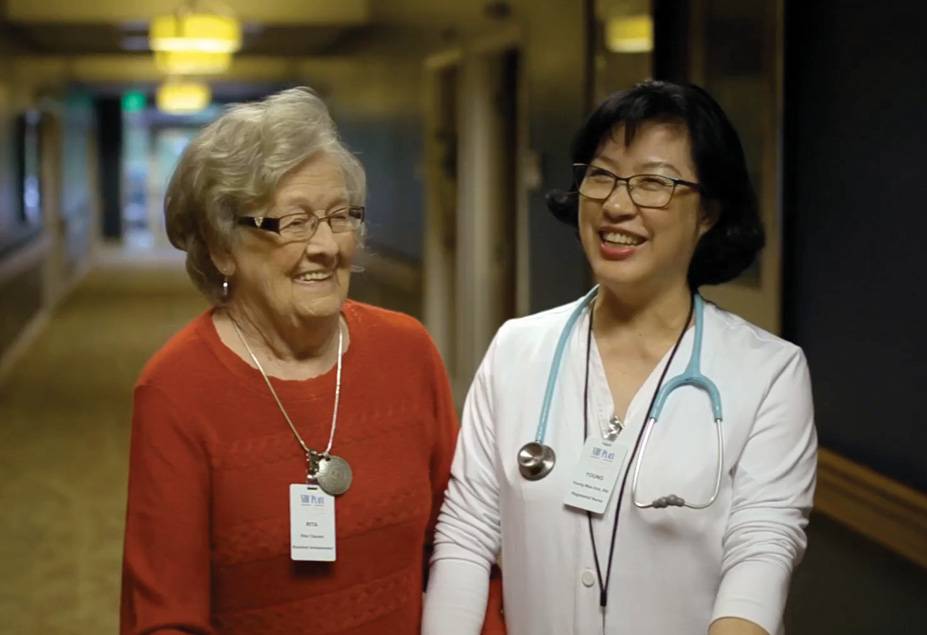In this third installment of our nutrition series, we are joined again by Amy Wootton, RDN, LDN, Director of Nutrition Management at MatrixCare. Our host, Kevin Whitehurst, SVP of Skilled Nursing Solutions, discusses the importance of using nutrition therapy for diabetes management. Hear their recommendations for creating a nutrition plan catered to individuals diagnosed with diabetes.
Amy ties her relationship with diabetes to nutrition therapy and discusses the prevalence of diabetes today. Listen in as she explains common factors that lead to hyperglycemia and hypoglycemia. And, with tips for individualized meal planning and snacks – it’s an episode you won’t want to miss.
Topics discussed during today’s episode:
- [01:07 – 02:41]: Amy explains her relationship with diabetes and why, more than ever, nutrition therapy for diabetes management is so important.
- [02:50 – 03:52]: Recommendations for a nutrition plan for someone diagnosed with diabetes.
- [04:04 – 06:04]: Common factors that lead to hyperglycemia and hypoglycemia.
- [06:12 – 07:31]: The main areas of focus for diabetes management.
- [07:47 – 08:56]: Individualized meal planning and snacks.
- [09:07 – 10:59]: How adopting a nutrition therapy approach for a more liberalized diet is leading the change to better management in skilled nursing facilities and rehab centers.
- [11:14 – 12:25]: Amy wraps up by describing the importance of having an interprofessional team in place to successfully manage nutrition therapy.
Resources
- Learn more about our nutrition management solutions at: https://matrixcare.com/nutrition-management/
- Catch up on part I and part II of this nutrition podcast series
- Find out more about nutrition therapy for diabetes management
- Listen to more episodes of the Post-Acute POV
Transcript
Speaker 1
Hi, and welcome to the Post-Acute Point of View, our discussion hub for healthcare technology in the out of hospital space. Here, we talk about the latest news and views on trends and innovation that can impact the way post-acute care providers work. And we take a look at how technology can make a difference in today’s changing healthcare landscape in both home-based and facility-based care organizations and the lives of the people they serve. Today, we hear from Kevin Whitehurst, Senior Vice President of Skilled Nursing Solutions for MatrixCare and his special guest. Let’s dive in.
Kevin Whitehurst
Hi, this is Kevin Keith Whitehurst, Senior Vice President MatrixCare. And I want to thank you all for joining us today. I’m here today with Amy Wootton, the Director of Nutrition Management at MatrixCare. We’re going to be talking about nutrition therapy for diabetes management. So why don’t we go ahead and get started, Amy. Nutrition therapy is such a great topic and you chose to focus on diabetes this time. So can you tell our listeners why more than ever diabetes management is so important?
Amy Wootton
Well, personally, diabetes plays a personal role for me, my husband is a diabetic, my parents are diabetics and I started my career based on my grandmother being a diabetic. And she introduced me to a dietician who was teaching her how to manage her diet. So that’s really where it all began for me. And it makes me focus on this topic often, but really older people have higher rates of diabetes. In fact, more than a quarter of Americans over the age of 65 are diabetic. The prevalence of diabetes in longterm care setting is estimated to range from 25 to 34%, which is equal to or higher than trends seen in general population. Therefore, it’s not surprising that it’s one of the most common diagnosises in older adults that require management and care communities.
Amy Wootton
An older adult residing in long-term care facility may have unpredictable meal consumption, under nutrition, anorexia, impaired swallowing. It’s attributed really to several age-related factors, such as sarcopenia, organ failure and an overall higher level of inflammation. The diagnosis is linked to not only additional disease burden, but also higher costs for caregivers as recognized under the patient-driven payment model, sniffs or skilled nursing facilities, excuse me, are now able to offset these costs under the non-therapy ancillary comorbidities by receiving two points for an active diabetes diagnosis. Long-term care costs for people with diabetes were estimated at 19.6 billion back in 2012 and costs haven’t gone down. So managing and understanding what affects blood sugar level variances are key to not only allow staff to provide appropriate care, but for that financial stability in senior living organizations.
Kevin Whitehurst
Wow, those are some really interesting statistics. So Amy, what do you recommend when it comes to a plan of care for a person diagnosed with diabetes?
Amy Wootton
Sure. Treatment approaches specific to diabetic patients should include medication, exercise, education, lab monitoring, weight fluctuations, but it also should be mainly focused on nutrition needs as that is the essential part of this management and overall plan of care. Last February, for the first time, the American Diabetes Association issued detailed position statement on the diabetes care of elderly patients in long-term care facilities, their guidance was glycemic goals need to be personalized, simplified treatment regimens, the diabetes diet is outdated and ineffective and should be dropped, and the use of sliding scale insulin is to be avoided. These guidelines urge healthcare practitioners to administer individual care for each patient when developing those treatment strategies to achieve that optimal glycemic control and meet dietary needs and prevent any future diabetes complications. Nutrition approaches can include snacking, food awareness, education, food from outside sources, all the meal consumption avenues that may happen so that problems can be managed.
Kevin Whitehurst
Really interesting. So I understand that there are risks that caregivers should know about. Can you talk about some of the common factors that can lead to hyperglycemia and hypoglycemia?
Amy Wootton
Sure. This is the tricky part. So impacts to blood sugar levels for hyperglycemia and hypoglycemia need to be understood by all of your staff members. This involves recurrent training and guidance in order to recognize the signs and symptoms of both. In that statement last year from the ADA on senior care for hypoglycemia, they said the risk for hypoglycemia is the most important factor in determining glycemic goals due to the catastrophic consequences in this population. The guidelines note that the strongest predictors of severe hypoglycemia instances are advanced age, recent hospitalization and polypharmacy, which is pretty much the profile, but typical nursing home resident. Hypos present differently in elderly. Instead of the heart pounding, sweaty, trembling lows that many nurses are used to, hypos in the elderly present with confusion, delirium, dizziness, with little or no physical signs until fainting. And we know falls are the leading cause of death from injury among seniors. And of course, a hypo is a good recipe for a fall off in an elder.
Amy Wootton
Hyperglycemia or elevated blood sugars can be caused by infection, stress, wound healing, certain drug interactions, and some diagnosises as well as basic increased insulin resistance of our body. Leaving residents high is not the answer as it leads to dehydration and urinary incontinence. So finding that middle ground is important. To help residents be successful in management of diabetes, caregivers can provide blood glucose monitoring, medication management, individual scheduled meals and snacks. And since that sliding scale insulin regimens are no longer recommended, addressing and adjusting current medication regimens that are possibly carried over from the hospital setting are imperative. Caregivers like dieticians working with the population can help prevent hypoglycemia by offering patients appropriate nutrition education, as well as your members, as part of that care plan. And each of these strategies play a role in treating hyper or hypoglycemia.
Kevin Whitehurst
Thank you so much. And you covered a lot of areas. Can you recap some of the main areas of focus in diabetes management for our listeners?
Amy Wootton
Sure. I’ll just give a little more information about senior living environments. They’re more often at the receiving end of care transitions. Upon admission, transition care documentation should include things like the current meal plan, their activity level, prior treatment regiments, lab tests like A1C, lipids and renal function, hydration information, previous episodes of hypoglycemia. This will initiate a care plan process that will limit risk and help plan for proper diabetes management. Specific levels of lab values should be understood by the team. We should aim to keep hemoglobin A1C, which reflects the blood glucose status over a 90-day period between eight and 8.9 for our seniors. Fasting glucose or before meal glucose should be 100 to 180, and bedtime glucose around 110 to 200, unless these levels still cause any kind of symptomatic type concerns. And institutional level challenges in the senior settings exist for diabetes management. And these include staff turnover and lack of familiarity with the residents in recognizing those symptoms, lack of knowledge about diabetes in general and diabetes management, restrictive diet orders, and just poor care plans. By having strategically put in care plans for diabetic residents, leaders can avoid these challenges, Kevin.
Kevin Whitehurst
That is such good information. Thank you so much, Amy. Can you tell our listeners about individualized meal planning and snacks? You brought that up earlier in the conversation, and I know it’s a very important that they understand this in long-term care.
Amy Wootton
Absolutely. Individual meal plans and snacks are imperative and recommended. Managing nutrition therapy is a key puzzle piece to care communities serving those senior populations. Dieticians and dietary team members should develop individual meal plans for patients that include a wide variety of foods and beverages to avoid dehydration, of course, and unintentional weight loss versus issuing that strict calorie-restricted diabetic diets, so to speak. Meal plans tailored to an individual’s culture, preference and personal goals increases the quality of life, overall satisfaction with meals and improve nutrition status. Specifically care plans for nutrition should include things like individual meal plans to offer a wide variety of food and beverages, honoring personal food preferences is a must, providing dining options in regard to when they want to eat, where they want to eat, the type of meals they want to eat. Considering a general diet meal plan that incorporates the consistent carbohydrate mindset with a wide variety of food choices. A detailed preference focus nutrition software like MealTracker can do just this. Individually planning residents meals and snacks can be a critical piece of treatment plan for diabetics.
Kevin Whitehurst
Great information. So you used a term called liberalized diet and nutrition therapy. And you talked about using that more. Can you talk to our listeners about what that actually means?
Amy Wootton
Sure. Adopting a nutrition therapy approach for a more liberalized diet is leading the change to better management in skilled nursing facilities and rehab centers. According to the ADA position statement that I referenced earlier, the care for diabetes in these facilities, more liberalized diets show improvements in consumption of food and beverages, which assist to avoid unintentional weight loss and dehydration. They give guidance to care settings that state, while carbohydrate intake should be taken into consideration, that no concentrated sweets or that no sugar diet order are ineffective for glycemic management. And they shouldn’t be recommended, instead that consistent carbohydrate meal plan that allows for that more variety of food choices may be more beneficial for both nutrition needs and the glycemic control. Some care settings adapt that consistent carbohydrate diet plan for diabetics as a standing type order. The idea behind the CCHO or consistent carbohydrate diet is to monitor and program carbohydrate consumption for fewer spikes and dips throughout the day, even the week. In other words, the CCHO diet keeps the carbohydrate intake in the same throughout the entire day. And that assigns about 15 grams of carbohydrates, which equals one carb.
Amy Wootton
We have best practice recommendations for liberalizing the meal plan for diabetics. And I keep a rule of thumb of five, include three to five servings of carbs per meal. And remember that 15 grams is equivalent to one. Choose whole grains, and they include more fiber, which slows that absorption, it stabilizes blood sugar. Eat four to six ounces of protein, include healthy fats and limit that saturated fats and avoid trans fat, which is processed or baked goods, usually found. These basic rules will help you build a foundation for a healthy, consistent carb diet plan.
Kevin Whitehurst
Wow, that’s really useful information. Thank you so much for that, sharing a lot of valuable insights into the diabetes management. Is there any more information you want to share for skilled nursing and rehab care centers before we close out?
Amy Wootton
Absolutely. It’s very important that an interprofessional team is in place to manage this care and end the nutrition piece, because the dietician and the food managers can’t do it by themselves. This includes embracing the dietary manager, registered dietician as part of that team and helping them make the meal plan that’s best for your resident population. These experts now have nutrition software solutions that provide them the tools needed. MealTracker allows you to build your diabetic consistent carb menu that fits your individual culture at your facility and can easily be customized for that individual need of the residents and preferences, reaching that goal to a specific individualized meal plan as mentioned earlier.
Amy Wootton
Meal trackers also helps you find the exact carb count of food items when building your menu through an integration with the latest USDA FoodData Central. And that helps you find the exact food item that you’re serving at your facility for that detailed nutrient analysis and define those carbohydrates. The staggering number of residents in our senior living population with diabetes requires advanced software to better manage both clinically with that care plan and meal planning. So look to MatrixCare MealTracker to really help you.
Kevin Whitehurst
And we have hundreds and hundreds of providers who have already done that. No wonder MealTracker is so popular with providers. So we want to thank everyone for joining us today. We’re at the bottom half of the hour and really great topic, nutrition therapy for diabetes management with MealTracker. So also want to thank you again, Amy Wootton for that wealth of information. Thank you so much for sharing.
Amy Wootton
Oh, thank you for having me once again, Kevin.
Speaker 1
That concludes the latest episode of the Post-Acute Point of View from MatrixCare. We have a lot of guests and topics coming up that you won’t want to miss. So be sure to subscribe. If you’ve enjoyed today’s podcast and if you have a topic you’d like us to discuss, leave us a review. To learn more about MatrixCare and our solutions and services, visit matrixcare.com. You can also follow us on LinkedIn, Twitter, and Facebook. Thank you for listening. Be well. And we’ll see you next time.




